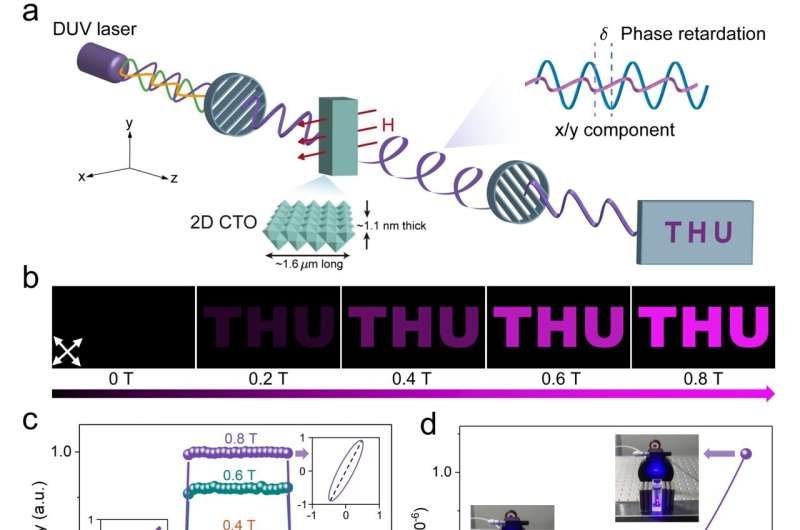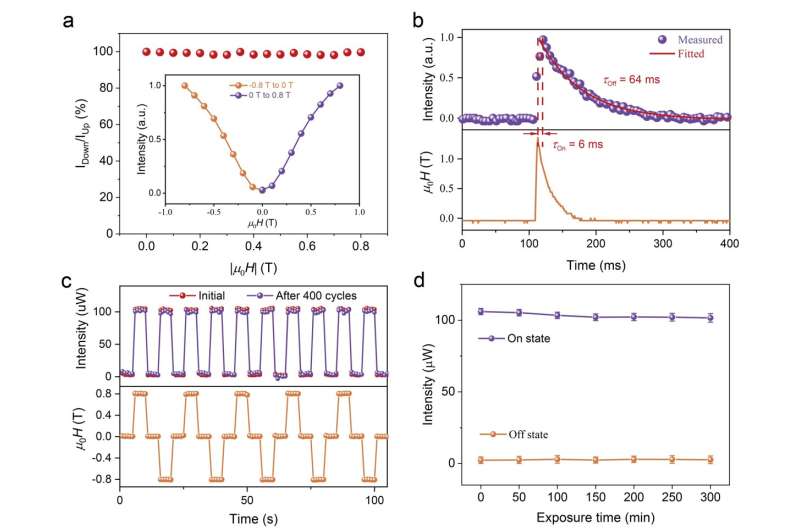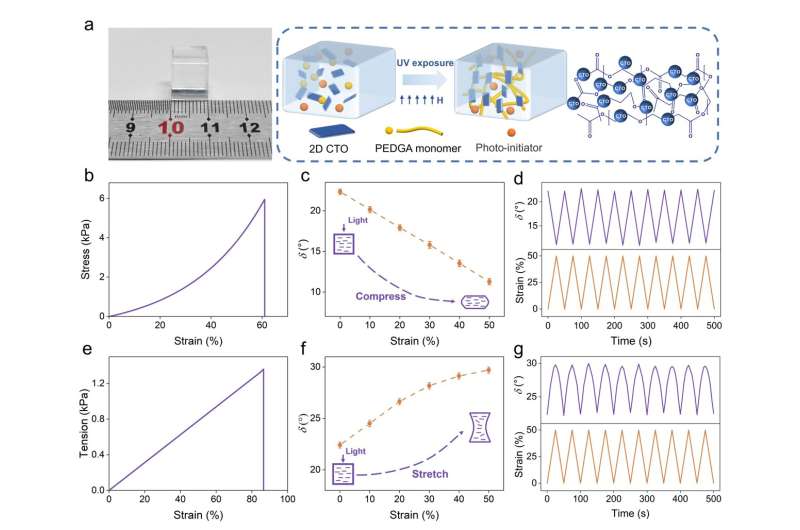Fig. 1. a) Schematic of the optical setup for magneto-optical measurements. b) Photographs of the patterned paper precoated with UV-excitable purple phosphor in the magnetic range of 0 T to 0.8 T, with an interval of 0.2 T (white arrow represents the transmission axis of the polarizer). The wavelength of DUV light is set as 303 nm. c) Intensity of transmitted DUV light versus magnetic field in a forward and reverse scanning. Insets: polarizations of the transmitted DUV light without and with a magnetic field of 0.8 T. d) DUV modulation by controlling the distance between permanent magnets. Credit: Youan Xu, Baofu Ding, Ziyang Huang, Lixin Dai, Peng Liu, Bing Li, Wei Cai, Hui-Ming Cheng, and Bilu Liu
A birefringence based light modulator that works in the wavelength region of < 350 nm plays a vital role in DUV beam shaping, high density data storage, semiconductor micro-nano processing and photolithography. Actually, a series of DUV birefringent materials, including single crystals of α-BBO, MgF2, Ca(BO2)2, and α-SnF2, have thus been made and commercially used. However, these birefringent elements have fixed birefringence, limiting their capability of continuous light modulation.
Liquid crystals (LCs) are another kind of birefringent materials, of which birefringence is tunable via the molecular alignment by external electrical or magnetic stimuli. Up to now, the commonly used LCs are mainly based on organic molecules or polymers, which are not stable under DUV light due to photochemical degradation effects. Meanwhile, DUV can also induce free radicals in some organic groups, and initiate their polymerization, which disorders the alignment and the resultant birefringence of LC. Therefore, organic LC cannot modulate DUV light.
In a new paper published in Light Science & Application, three teams of scientists, led by Professor Hui-Ming Cheng and Associate Professor Baofu Ding from Shenzhen Institute of Advanced Technology, CAS, Professor Wei Cai from Xi'an Research Institute of High Technology, Professor Bilu Liu from Tsinghua University, China, cooperatively synthesized two-dimensional (2D) inorganic cobalt-doped titanate (CTO) LC by using a wet chemical method. The 2D LC has large magnetic & optical anisotropy as well as high transmittance of > 70% in the wavelength of 300 ~ 350 nm, which enables the transmitted DUV modulation in a magnetic and portable way (Fig. 1).
Fig. 2. a) Reversibility test of transmitted DUV intensity. Insets: field-intensity correspondence at an interval of 0.1 T from -0.8 T to 0.8 T. b) Transient magneto-optical signal of transmitted DUV light (upper panel) in response to a magnetic pulse with a peak strength of 1.3 T (lower panel). c) Cycling test about stability of 2D CTO LC modulator: time-dependent intensity of transmitted DUV light (upper panel) as the magnetic field of ±0.8 T is periodically turned on and off per 10 s (lower panel). d) Fatigue test of transmitted intensity versus exposure time under continuous DUV irradiation for 300 min. Magnetic field of 0.8 T is kept in turn-on status. DUV light intensity: 200 mW cm⁻². Credit: Youan Xu, Baofu Ding, Ziyang Huang, Lixin Dai, Peng Liu, Bing Li, Wei Cai, Hui-Ming Cheng, and Bilu Liu
Fig. 2 summarizes the desired performance of the 2D CTO LC based DUV modulator, as evidenced by its good reversibility, fast response at the millisecond level, excellent durability and DUV stability.
The magneto-birefringence effect of 2D CTO LC make it applicable in the preparation of flexible DUV birefringent optical hydrogel. By adding a small amount of monomer and photo-initiator into 2D CTO suspension, a DUV birefringent hydrogel was prepared via UV curing during exertion of magnetic field.
Once the hydrogelation is completed, the magnetically aligned 2D CTO nanosheets can be fixed inside the hydrogel and all their long axes parallel each other, even after removal of the magnetic field. The CTO hydrogel can serve as a transparent mechano-optical crystal, through which the DUV light can be in-situ modulated without direction alteration in a mechanical way (Fig. 3). The 2D CTO based hydrogel is the first birefringence-tunable element that can continuously tune the DUV light in a mechanical way.
Fig. 3. a) A photo of the CTO hydrogel (left) and scheme (right) of its fabrication process. b) Compressive stress–strain curves of the CTO hydrogel. c) Phase retardation induced by the uniaxial compression of hydrogel in the direction of light propagation. d) Cycling test for the reversibility and stability of DUV modulation during compression. e-g) Similar to b-d, but presenting the process of stretching. Credit: Youan Xu, Baofu Ding, Ziyang Huang, Lixin Dai, Peng Liu, Bing Li, Wei Cai, Hui-Ming Cheng, and Bilu Liu
This work may extend birefringence-tunable optics that are currently used in visible and infrared regions to the DUV region, which is important for high density data storage, semiconductor micro-nano processing and photolithography.
More information: Youan Xu et al, Deep ultraviolet hydrogel based on 2D cobalt-doped titanate, Light: Science & Applications (2023). DOI: 10.1038/s41377-022-00991-6
Journal information: Light: Science & Applications
Provided by Light Publishing Center, Changchun Institute of Optics, Fine Mechanics And Physics, CAS


























